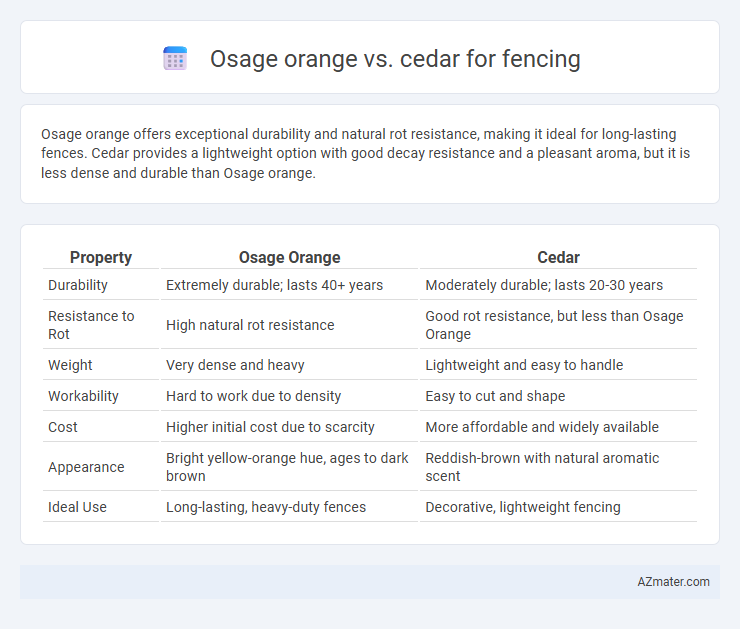Osage orange offers exceptional durability and natural rot resistance, making it ideal for long-lasting fences. Cedar provides a lightweight option with good decay resistance and a pleasant aroma, but it is less dense and durable than Osage orange.
Table of Comparison
| Property | Osage Orange | Cedar |
|---|---|---|
| Durability | Extremely durable; lasts 40+ years | Moderately durable; lasts 20-30 years |
| Resistance to Rot | High natural rot resistance | Good rot resistance, but less than Osage Orange |
| Weight | Very dense and heavy | Lightweight and easy to handle |
| Workability | Hard to work due to density | Easy to cut and shape |
| Cost | Higher initial cost due to scarcity | More affordable and widely available |
| Appearance | Bright yellow-orange hue, ages to dark brown | Reddish-brown with natural aromatic scent |
| Ideal Use | Long-lasting, heavy-duty fences | Decorative, lightweight fencing |
Introduction to Osage Orange and Cedar Fencing
Osage orange, known for its exceptional hardness and natural rot resistance, offers durable and long-lasting fencing ideal for livestock and boundary marking. Cedar fencing stands out for its aromatic properties, natural insect repellence, and resistance to decay, making it a popular choice for aesthetic and functional outdoor enclosures. Both woods provide sustainable options, with Osage orange excelling in strength and cedar favored for its lightweight and weather-resistant qualities.
Wood Durability: Osage Orange vs Cedar
Osage Orange wood is highly regarded for its exceptional durability and natural resistance to rot, insects, and decay, making it an ideal choice for long-lasting fences. Cedar wood also offers good durability with natural oils that protect against insects and moisture, but it generally requires more maintenance to preserve its lifespan compared to Osage Orange. In terms of wood durability, Osage Orange outperforms Cedar by providing superior strength and extended resistance to environmental elements.
Decay and Insect Resistance Comparison
Osage orange wood exhibits exceptional decay resistance and natural insect repellency due to its dense grain and high tannin content, making it a durable choice for fences in harsh outdoor conditions. Cedar also offers good decay resistance and insect deterrence but is generally less dense, leading to a shorter lifespan compared to Osage orange when exposed to prolonged moisture and pest activity. For fencing applications, Osage orange typically outperforms cedar in longevity and resistance to fungal decay and wood-boring insects.
Strength and Structural Performance
Osage orange wood is renowned for its exceptional strength and density, making it one of the toughest choices for fencing that resists warping and splitting over time. Cedar, while less dense, offers natural resistance to decay and insect damage, providing durability with a lighter weight that eases installation. In terms of structural performance, Osage orange excels in load-bearing capacity and longevity, whereas cedar balances strength with enhanced weather resistance and aesthetic appeal.
Maintenance Requirements
Osage orange is highly valued for fence posts due to its exceptional rot resistance and minimal maintenance requirements, needing only occasional inspections and minor repairs. Cedar also offers natural decay resistance but typically requires more frequent treatment or sealing to prevent weathering and insect damage. Both woods benefit from proper installation and drainage to maximize lifespan, though Osage orange generally demands less ongoing upkeep than cedar.
Cost Analysis: Initial and Long-Term
Osage orange offers a higher initial cost than cedar due to its dense wood and labor-intensive processing, but it delivers superior longevity and resistance to rot, reducing replacement expenses over time. Cedar is generally more affordable upfront and easier to work with but may require more frequent maintenance and treatment to prevent decay, leading to higher long-term costs. Factoring in durability and maintenance, Osage orange fences provide better cost efficiency over decades despite the steeper initial investment.
Sourcing and Environmental Impact
Osage orange wood is sourced primarily from native North American regions, known for its durability and natural resistance to rot and pests, making it a sustainable option for fencing without extensive chemical treatments. Cedar is often sourced from Western red cedar or Eastern white cedar forests, with responsible harvesting practices in place that emphasize forest regeneration and biodiversity preservation. Both woods are valued for their lower environmental footprint compared to treated lumber, but Osage orange's slower growth rate and dense hardness typically result in a longer-lasting fence with minimal environmental disruption.
Installation Considerations
Osage orange wood offers exceptional rot resistance and strength, making it ideal for fence posts but requires specialized tools due to its hardness, which can complicate installation. Cedar is lighter and easier to handle, allowing for faster installation with standard equipment, though it may need treatment to enhance durability against weather and insects. Proper post spacing and soil conditions also influence the ease and longevity of both Osage orange and cedar fencing installations.
Aesthetic Differences
Osage orange offers a vibrant, bright yellow-orange hue that deepens to a rich, warm color over time, enhancing fence aesthetics with a bold, rustic appeal. Cedar provides a smooth texture and natural reddish-brown color that weathers to a soft gray, creating a classic, elegant look ideal for traditional or modern settings. Both woods showcase distinct grain patterns, with Osage orange's dense, knotty appearance contrasting Cedar's straight, fine grains, influencing the overall visual impact of the fence.
Final Recommendations: Choosing the Right Fence Wood
Osage orange offers exceptional durability and natural pest resistance, making it ideal for long-lasting fence posts in harsh environments, while cedar provides a balance of aesthetic appeal and moderate rot resistance suitable for decorative fencing. When prioritizing strength and longevity, Osage orange is the superior choice due to its dense, heavy wood and minimal maintenance needs. For projects emphasizing visual appeal and easier workability, cedar is recommended for its attractive grain and lighter weight, despite requiring more frequent upkeep.

Infographic: Osage orange vs Cedar for Fence
 azmater.com
azmater.com